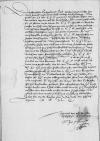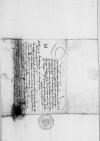Letter #4910
Ioannes DANTISCUS to Albrecht I von Hohenzollern-AnsbachGuttstadt (Dobre Miasto), 1540-03-24
| received Königsberg (Królewiec), 1540-03-25 Manuscript sources:
Auxiliary sources:
Prints:
| ||||||||||
Text & apparatus & commentary Plain text Text & commentary Text & apparatus
 GStA PK, HBA, C1 No 651 2 unnumbered
GStA PK, HBA, C1 No 651 2 unnumbered
Dem durchlauchten, hochgebornen fursten und herren, herren
 GStA PK, HBA, C1 No 651, 1 unnumbered
GStA PK, HBA, C1 No 651, 1 unnumbered
Durchlauchter, hochgeborner furst, / hochgunstiger, lieber her unnd freundt. / Unser freuntliche, willige dinste zuvoran. /
Wir haben den XII dits E(wer) F(urstlichen) D(urchlauch)t mit yrem lauffenden bothen / und den andern tag dornach bei koniglichem kemmerer(r) cf.
Neues ist nicht sonders an uns kommen, / das E(wer) F(urstliche) D(urchlauch)t nicht wuste. / Es wirt uns geschrieben, / das
Dat(um) bei unser kirchen zur
Io(an)nes / qui sup(ra) ma(n)u p(ro)pria s(ub)s(crips)it adscribed, in the hand of Dantiscus⌈

